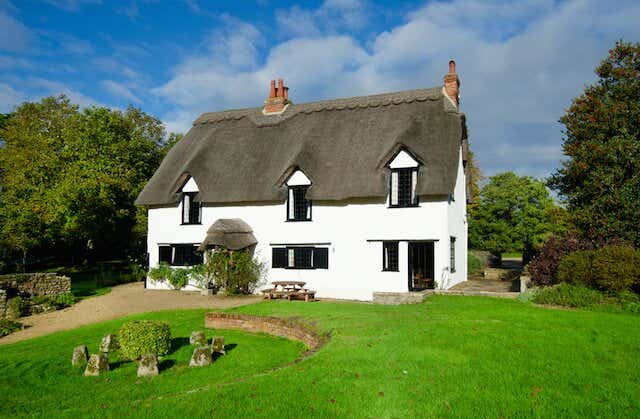Insurance for houses with thatched roofs

 Insurance for houses with thatched roofs
Insurance for houses with thatched roofsWhat is a Thatched house?
Thatched housing was once a symbol of poor communities in the British countryside, as the materials used in creating the signature roofs were so readily available. The result gave buildings a lighter roof that could be held up with less timber than other types of house, and thus were built at a cheaper cost.
Today, quite a lot has changed and thatched homes are now a far wealthier symbol, evoking images of the idyllic countryside and 18th-century villages. The building of thatched houses is said to be on the rise in the UK despite the difficulty in sourcing cheap materials for the thatched roofs and the complications in finding appropriate insurance.
With some local authorities being reportedly more likely to grant permission for new thatched houses to be built, some homebuyers are now getting the best of both worlds. They're having a home designed for modern living, with the quaint village look of a thatched roof. So if you're planning to buy a thatched home, or you already have one, then you should learn more about thatched house insurance.
Read on to find out more about thatched house insurance, and how you can minimise damage to your thatched roof, and make sure you have appropriate insurance for thatched cottages. Therefore, avoiding having to make any claims in the future, which is likely to result in higher premiums on your insurance policy for the following year.
What is thatched property insurance?
Thatched house insurance is a type of non-standard home insurance. Non-standard policies consider the unique requirements of thatched homes. Providing you with a fairer policy for thatched house insurance than you might get with a regular home insurance policy.
Your standard buildings insurer will not necessarily have a lot of expertise or experience with insuring thatched homes. So you might find that they're not as understanding when you need to make a claim. Or in many cases, they will simply refuse to provide you with insurance altogether.
If you have a home with a thatched roof, you might find it harder to get cheap buildings insurance premiums. That’s because insurers are weighing up the risk of protecting your property. Thatched roofs are generally harder to maintain and come with a greater risk of fire damage than regular roofs. On top of that, thatched roofs often require work carried out by specialists, which might be more expensive than your usual maintenance work.
With thatched house insurance, insurance companies will usually be able to give you a better deal, and generally will be able to tailor a plan to suit you. This means you could get a cheaper deal on your buildings insurance premiums.
Although a fire is no more likely to start in a thatched house than a regular house, the materials used in thatched roofs can cause a fire to spread more quickly and cause more damage. This means the risk is far greater and repair costs will be much higher. As insurers are weighing up the risk or insuring your property, they will see that if a fire were to damage your home, they may have to pay out much more than if you had a fire in a home built with standard materials.
If your thatched house is a listed building then beware of making any alterations or reparations to the property as some changes might be considered to be against the rules set out by the statutory bodies responsible for grading buildings.
Read our guide to listed buildings insurance for more information on what to do if you have a listed building with a thatched roof to find out more about the extra risks that come with making repairs and taking out insurance.

Do I need thatched house insurance?
If you have a newer thatched property (i.e. one that was built in the last 50 years or so) then you may find the materials used are of a higher quality than if you have one from the 18th century. If that's the case you might find a regular buildings insurance provider willing to insure your property. You’re much less likely to find a standard home insurer willing to insure your thatched house, especially if it was built over 150 years ago. If it’s graded as a listed building too then it will be much harder to get a standard insurer to cover you.
However, you might want to get specialist insurance from a non-standard home insurance provide anyway. As mentioned previously, a non-standard home insurance provider will have a better understanding and more experience when it comes to insuring properties with thatched roofs.
This could lead to cheaper premiums and better quality specialist repairs that meet the needs of your property.
Read our guide to non-standard home insurance to learn more.
How to reduce fire risk to your thatched house
Aside from making sure to shop around, and compare insurance for your thatched roof cottage, with the wider insurance market for the best deals. Another way to reduce your premiums is to reduce the risk of fire damaging your home.
Insurers will usually want to know the rebuild value of your home, which is essentially how much it would cost to build your home from scratch if it were completely destroyed in a fire.
The higher this figure is the more likely it's that you will have to pay higher premiums on your thatched house insurance, so you will want to do whatever it takes to avoid any fire in your home. However, reducing the chance of a fire and showing you take your property’s protection very seriously, will help your chances with getting a better deal with the insurer.
One way of reducing the risk of fire is to install fire resistant barriers into your thatched roof, as well as spraying the roof with fire retardant spray.
Along with this, be sure to install smoke detectors around the thatched roof area, as well as around the rest of the house. Finally, make sure to get regular chimney checks and electrical wiring inspections. This could help you discover any fire hazards well in advance of it becoming an actual threat to your home.